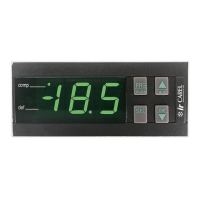
Do you have a question about the Carel IR32 Series and is the answer not in the manual?
| Model | IR32 Series |
|---|---|
| Type | Electronic Controller |
| Application | Refrigeration |
| Outputs | Relay |
| Resolution | 0.1 °C |
| Analog Inputs | NTC, PTC, 4...20mA, 0...10V |
| Digital Inputs | Configurable as digital or analog |
| Relay Outputs | Up to 3 (depending on model) |
Important precautions for controller installation, including environmental factors and connection guidelines.
Describes the Direct control action mode, its main parameters, and operational logic for controlling variables.
Explains the factory-set Reverse mode, its core parameters, and how outputs energize based on variable changes.
Explains the Dead-Zone mode, defining a neutral range around the set-point to avoid output changes.
Describes the PWM mode for proportional control, detailing its logic and parameters for modulating outputs.
Details the Alarm mode, where outputs signal generic or specific high/low alarm conditions with specific parameters.
Explains how a digital input selects between Direct and Reverse modes, changing set-points and differentials.
Describes how a digital input switches set-points and differentials while maintaining Direct mode.
Details how a digital input switches set-points and differentials while maintaining Reverse mode.
Explains the mode with two set-points, one for Direct and one for Reverse operation, for models W and Z.
Step-by-step guide on how to modify the primary set-point (St1) value using the keypad.
Details the procedure for modifying "C" type configuration parameters using password access.
Step-by-step guide on how to change the controller's operating mode by modifying the C0 parameter.
Describes St1 and St2 parameters, their access modes, validity, and operating ranges for control.
Details C0 (mode of operation) and control logic parameters like differentials and authority.
Offers guidance on selecting the appropriate starting mode for customizing the controller's operation with C33.
Provides practical examples demonstrating the application of special functions and parameter settings in various scenarios.